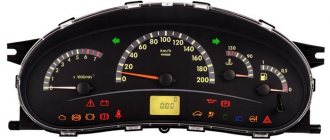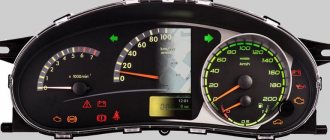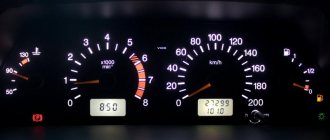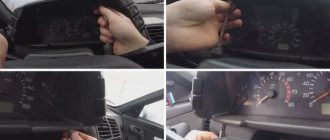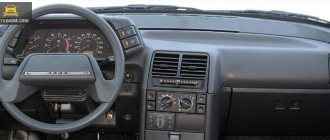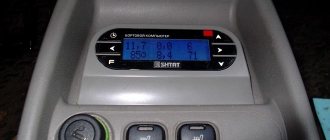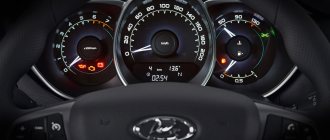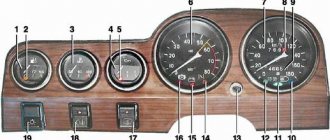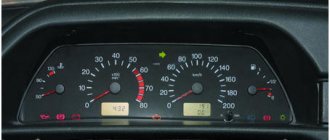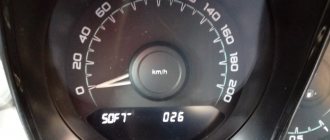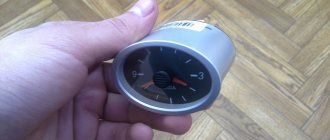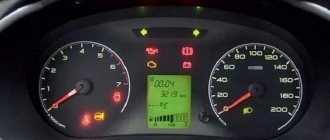While holding the daily mileage button, turn on the ignition. After 5 seconds the panel goes to self-diagnosis. Let's release the button.
1. the first screen shows the firmware version of the on-board computer;
2. The second screen diagnoses the performance of all elements of the LCD display, turning them all on at the same time. In the event of a malfunction, one of the elements will not light up. I note that one of the elements on the left of the clock display is missing for all cars, because... for both types of time indications (12-hour and 24-hour) this element is not used;
3. The third screen shows the remaining fuel in the tank accurate to the nearest liter and provides more accurate information than the standard graphic bar. If there is an open circuit or short circuit fault, the display shows “- — -“. It is important to note that the fuel level sensor located in the gas tank does not reflect the amount of fuel filled above the 50 liter limit. Those. if you filled the gas tank with 51 or more liters, then the BC in diagnostic mode will still show only 50 liters;
4. The fourth screen informs about the presence or absence of malfunctions of the coolant level sensors, fuel level sensor and fuel consumption information system (only if the car has a BC with firmware 6002). If there are no existing or stored faults, the display shows “- — — — -“. – Stored and existing malfunctions of the coolant temperature sensor are displayed on the display in the form “- - TO” when the circuit is open, “- -TC” when the circuit is short-circuited. Coolant temperature sensor malfunctions are not critical; You can ignore the “TO” fault if the engine is cold. – Stored and existing faults of the fuel level sensor are displayed in the form “-JO- -” when the circuit is open, “-JC- -” when there is a short circuit. – Stored and existing malfunctions of the fuel consumption information system are displayed as “D- — — -” in the absence of a fuel consumption signal. Malfunctions of the fuel consumption information system are only taken into account if the vehicle is equipped with an on-board computer. All “stored sensor faults” listed on the page are faults that were detected but no longer appear. If there are several stored or existing faults, they are shown on the same line.
Decoding the functions of the Lada Largus FL on-board computer
Lada Largus FL (facelift from 2022) received a number of exterior and interior updates. For example, the car received a new instrument cluster with an on-board computer (OB) function. The capabilities of the BC are presented in the Lada Largus FL operating manual.
When you briefly press the “Up” or “Down” buttons on the right steering column switch, the following information is displayed sequentially on the on-board computer display:
A – “Total mileage counter”; B – “Trip mileage counter No. 1” (from the moment the readings are reset); C – “Total fuel consumption” (from the moment of group zeroing of readings); D – “Average fuel consumption” (from the moment of group zeroing of readings); E – “Current (instantaneous) fuel consumption”; F – “Calculated (approximate) range on remaining fuel”; G – “Trip mileage counter No. 2” (from the moment of group zeroing of the readings); H – “Average speed” (from the moment of group zeroing of readings); I – “Setting tire pressure” (in a variant); J – “Set value of the speed limiter or cruise control when the speed limiter or cruise control function is turned on” (in a variant); K – “Indication of outside air temperature”; L – “Indication of the current time” (optional).
Examples of data displayed on the on-board computer display:
* In conditions of insufficient airflow to the ambient temperature sensor (in a parking lot, when driving in a traffic jam, etc.), the readings may not correspond to the actual temperature. When the ambient temperature readings are from –3 to +3 °C, the “°C” symbol starts flashing, warning the driver about the possibility of ice. Recommendations for driving in icy conditions.
Misha RYABOV, presenter of the project “Auto on the B0 platform”
Today we have reached a localization level of 62% in terms of price. The list of devices produced here (mostly in Togliatti) includes stamped body parts (almost all are supplied to Avtoframos), all chassis parts, and interior elements - from the instrument panel to rubber mats. By the end of the year, we plan to increase the localization rate to 72% by launching motor creation. Naturally, localization will affect all cars on the B0 platform that will be produced by AVTOVAZ. These are two Renault models, one Nissan, two under the Lada brand. Changes in the Largus design caused by specific Russian operating criteria will also affect single-platform vehicles. For example, the next news under the Nissan brand will receive engine protection and reinforced front suspension arms.
Source: www.zr.ru
Resetting trip mileage counters and other parameters to zero
To reset the trip mileage counter No. 1, use the “Up” and “Down” buttons on the right steering column lever to select mode B “Trip mileage counter No. 1” in the on-board computer menu and press any of the “Up” or “Down” scrolling buttons ", hold it for a while. The selected value will first flash and then reset to zero.
Resetting the trip mileage counter No. 2 is possible only together with resetting a group of other on-board computer readings: – C “Total fuel consumption”; – D “Average fuel consumption”; – G “Trip mileage counter No. 2”; – H “Average speed”.
That is, when one of these readings is reset, the entire group is reset to zero. To reset a group of these readings, use the “Up” and “Down” buttons on the right steering column lever to select any of the modes C, D, G, H in the on-board computer menu and, by pressing any of the “Up” or “Down” scrolling buttons, hold it for a while. The selected value will first begin to flash, and then all four readings in the group will be reset to zero.
In addition, if the maximum value of the trip counters is exceeded, the parameters are reset automatically.
Emergency and service warnings:
— Warning about starting to move with low beams off;
— Warning about insufficient oil pressure when the engine is running;
— Motion warning with active handbrake;
— Warning about loss of communication with the ECM;
— Warning about starting to drive with an unfastened seat belt;
— Warning about low brake fluid level;
— Warning about lack of battery charge from the generator;
Explanation of some data after zeroing the readings
The greater the distance traveled since the last zeroing operation, the more stable and reliable the readings of average speed, average fuel consumption and range of fuel remaining in the tank will be.
During the first few kilometers of driving after resetting the calculated values, you may notice that the range of the fuel available in the tank increases while driving. This is due to the fact that the average fuel consumption since the last time the readings were reset is taken into account.
Average fuel consumption may decrease in the following cases: • the vehicle has finished accelerating; • the engine temperature has reached normal (and the calculated values were reset when the engine was cold); • You have left a busy city onto an open country road.
ALONG THE MOTHER VOLGA
With these ideas we went out onto public roads. Yes, you don’t notice a lot when cutting circles around a high-speed oval. For example, how well the suspension handles bumps of various sizes. The smoothness of the Largus is reminiscent of the similar Logan and Sandero. Small road imperfections simply dissolve on the way from the wheels to the body, and large ones, which are scary to even look at, are happily swallowed by the suspension, allowing you not to slow down. It’s comfortable, and with all this, the car reacts correctly and completely promptly to the driver’s commands. If you expect the reactions of a sports car from a hard-working station wagon with a high center of mass and energy-intensive suspensions, stand in line behind the rest of the car. There are sensitive tilts and slight delays in steering movement, but in general the car behaves predictably, at least at speeds allowed by our Traffic Rules.
Is 105 “horses” not enough for a car with a gross vehicle weight of under two tons? Those who expect acceleration, like during the take-off run of an airplane, go to the same line where lovers of refined maneuverability stand: the economical car has never been given extra power. I’ll tell the rest that with a half load (as annoying as it may sound, it was not possible to fill all the seats), the efforts of the sixteen-valve engine are completely enough for a brisk overtaking. The elastic motor pulls out from all speeds, and perfectly selected gear ratios in the boxes also simplify the planned maneuver. True, in order to spur the Largus, due to the closeness of the gear ratios in the box, you often have to jump not one, but two steps down. At first it’s not out of habit, but automaticity comes quickly. And along with it, the fuel gauge on the instrument panel is rapidly falling. As annoying as it may sound, short gears and average aerodynamics do not contribute to a moderate appetite. With fairly economical driving on country roads, fuel consumption for various drivers ranged from 8.5 to 10 liters per 100 km.
“Largus” is the first car in which you don’t remember that it was manufactured by AVTOVAZ. He is the first whose name is not ashamed to write in Latin. And for which I am not sorry to pay my hard-earned money. But most Russians look at it with distrust, because the most fundamental question remains open - about reliability in operation. Almost everyone in recent years was badly burned by buying models from the Volzhsky Automobile Plant, and, disappointed, went to their rivals. Maybe Largus can return them?
Misha RYABOV, presenter of the project “Auto on the BO platform”:
Setting the clock on the BC display
Setting the clock on the BC display (optional).
By briefly pressing any of the “Up” and “Down” buttons on the right steering column lever, go to mode L for displaying the current time on the on-board computer display.
When you press and hold any of the “Up” or “Down” buttons for more than 3 seconds, the clock goes into time correction mode, and the hour digits begin to blink (the minute digits do not blink). A single and short press on the “Up” or “Down” button will change the readings by one hour. By pressing and holding the Up or Down button for a long time, the hour values rapidly change to the desired current reading.
If, after adjusting the clock, you do not press the buttons for 5 seconds, the clock will automatically switch to the minute correction mode, and the minute digits will begin to blink (the hour digits will not blink). A single and short press on the “Up” or “Down” button will change the readings by one minute. When you press and hold the Up or Down button for a long time, the minute values quickly change to the desired current reading.
Informing about the need for maintenance
The service interval for your vehicle is 15,000 km or one calendar year, whichever comes first. When the response threshold is reached at 1,500 km or one month (whichever comes first) before the need for service, when the ignition is turned on, the indicator on the on-board computer screen turns on for 3 seconds
. From now on you can find the same icon in the menu.
When the response threshold is reached at 0 km or 0 days (whichever comes first) before the need to carry out service, when the ignition is turned on, the indicator on the on-board computer screen turns on for 3 seconds and the multifunction indicator in the instrument cluster constantly lights up in red
. After the service has been completed and the counters have been reset, these indicators and warning lights will go out.
Source
Lada Largus instrument composition icons
1 - ABS indicator. Lights up when the engine starts and goes out. Lights up when problems with the anti-lock braking system appear.
2 — Front safety pad. It lights up when a malfunction occurs, you should contact a specialist.
3 — Seat belt reminder. Lights up when you start the engine and glows if you are not wearing a seat belt.
4 — Signal lamp for disabling the front passenger airbag
5 — Heated rear window. Lights up when the rear window heating is turned on.
6 - Low beam. Lights up when the close beam mode is turned on.
7 - Distant light. Lights up when high beam mode is turned on.
8 — Rear fog lights. Lights up when the rear fog lights are turned on.
9 — Fog lights. Lights up when the fog lights are turned on.
10 — Designation electric amplifier. Lights up when there are dilemmas or when the electric amplifier is turned off.
11 - Warning lamp for door(s) not closed.
- Fuel level indicator lamp. Illuminates when the fuel level is low
- Turn signal indicators. They light up when they are turned on.
- Engine cooling water temperature indicator. Lights up when overheated.
- Engine oil pressure and level. Lights up at low level, pressure
- Warning light for the electrical engine start immobilizer system.
- Indicator for pre-heating system (glow plugs). Lights up when there is a fault.
- Battery warning lamp. Lights up when the battery charge is low.
9. Parking brake warning light and brake system fault warning light.
10. “CHECK ENGINE” indicator - check the engine. Lights up when there is a malfunction in the engine control system. You should contact specialists.
- Fuel level indicator.
- Dashboard firmware version
- Cooling water level indicator.
- Clock and time
Trip computer multitronics C590
Prehistory
In 2014 I learned what multitronics is. Almost immediately I bought the 731 model and installed it in my Logan. At the beginning of 2015, model 590 was released - the one that replaces the air duct. I hung my 731 from the glass onto the ceiling trim and started dreaming about a new product. So I drove until the last car was sold. During this time, I have accumulated a lot of positive experience from using this device. And I removed 731 and put it on a shelf in the country.
After 3 months, I carried out troubleshooting, during which I found out that the additional cable braid needed to be changed and there were glue smudges on the body that I could not remove. I put everything in its original box and put it away until “better times.”
Six months later, I started looking for the scythe in earnest. Found it for 900 rubles including delivery. Due to natural laziness, I couldn’t get to the savings account for another 3 whole months.
And after 9 months of using only a regular bookmaker, I threw away 731 on Avito “as is” for a modest 2200 rubles. My hard worker left on the same day. The new owner was not at all embarrassed that he would not have Air overboard, physically. ignition, analogue FLS and dimensions/gas input. I referred this to the price tag of 30 percent of the price of new. But he still didn’t fit the bill for me. Putting a 750togo body on a panel is ugly. Vestaplafon does not allow it to be placed on the ceiling.
Purchase
The moment of fulfillment has come. After 4 years, I finally bought 590. I was looking for version “C” - with voice. It was almost impossible to find these in the city, CLs are voiceless everywhere, but I found the one I needed.
Installation
First of all, I studied a lot of records on d2 and realized that the air duct definitely needs to be plugged. I couldn’t find parolon at home, so I went to the nearest chain hypermarket, where I bought a sponge for washing the car. I returned to the box and scattered the radio, beard and air duct. I started to bundle the cable. I pulled the connector out of the glove compartment. I attached a cable to it and hid the whole thing under the carpet at the passenger’s feet.
I laid a cable over the glove compartment
I took care of the air duct - pushed in a sponge, rolled up the mating surface with a piece of vibration insulation
I crimped the cable to size (for some reason it goes to the BC itself, and not to the obd as before).
Inserted all cables
Then I started wiring an additional cable and a temperature sensor. With the wires everything is as usual - 10,11 and 24 pins of the tidy. I inserted the sensor into the engine compartment and then realized that it was not long enough. Fortunately, the sensor is resistive and is not afraid of cable extension. I found 50 cm of 0.2mm2 spiral cable. The wire was spliced, soldered and everything was insulated. I wound electrical tape on top along the entire length.
The sensor was attached to the “gill” of the PTF cover. There it is blown and does not catch the heat from the engine/headlight. Moreover, the BC measures readings only at speeds above 20 km/h
The last step was to click the BC into place and assemble the interior
I made a brief adjustment - I chose the “M86” protocol, the ignition “physical”, the dimensions “physical”, the tank “FLS” “Tareed 7”. I was surprised by the abundance of additional parameters. There are flags for all lamps, and all misfires, all errors, and even the percentage of catalyst aging. I was very pleased with the opportunity to turn on the radiator fan at 1/2 speed at any coolant temperature (according to the firmware, I have 96g - 1st speed, 100g - 2nd speed) and, of course, the ability to forcefully turn on fan speed 2, before turning off the ignition. This will be very useful for cooling the radiator of the air conditioner in the summer, in the heat.
UPD
At the request of Svarog-RUS, I added a video on setting up corrections as in the dashboard. I don’t want to set it up according to the instructions; there you need to fill the tank up to the neck, roll out 25 liters or more, fill it full again and indicate the amount of fuel on the receipt. For Largus this is difficult, because everything depends on the tilt of the car, and you will have to drain about 20 liters
THE SAME “LOGAN”, ONLY “LARGUS”
“Everything here breathes Logan,” I involuntarily paraphrased a contemporary, as soon as I saw Largus. Although there are still differences between station wagons of foreign and Russian assembly. On the outside, for example, in addition to the unique front bumper and radiator mesh with a boat (by the way, the updates benefited the exterior), plastic linings were used on the wheel arches for the best protection of the body; The anti-gravel coating on the bottom has become thicker and approaches almost the door openings. By the way, “Largus” is protected from corrosion better than other models produced by AVTOVAZ: all body panels are galvanized outside and inside, the most modern painting equipment is already being installed in the new workshop (for now they are temporarily using capacity for the production of “Kalina”), and hidden cavities in This is the first time for local cars to be filled with wax.
One of the interesting differences in the cabin are the unique seats. With their simple forms, they resemble those installed in Logan, but they differ in both manufacturer and design. In the best configuration, which, by the way, was rolled out for testing, you can additionally adjust the lumbar support and the height of the pad. This set is completely enough to take a comfortable position. At least to those whom the Creator did not endow with an unusual figure. During the 400-kilometer run, my employee and I never remembered the seats. The best confirmation that you have a successful system under you.
As I remember, it was more spacious for me in the back seat in the Logan. No, the Largus is not cramped, but it’s not so easy on the legs. There is plenty of space on the shoulders, and even more so above the head. What's the matter anyway? The answer came from the front seat. The tall employee noted the longest longitudinal adjustment. In general, whoever doesn’t like it in the 2nd row should go to the “gallery”. I don’t remember a car that would be so comfortable and have a lot of space. Naturally, buses don't count.
